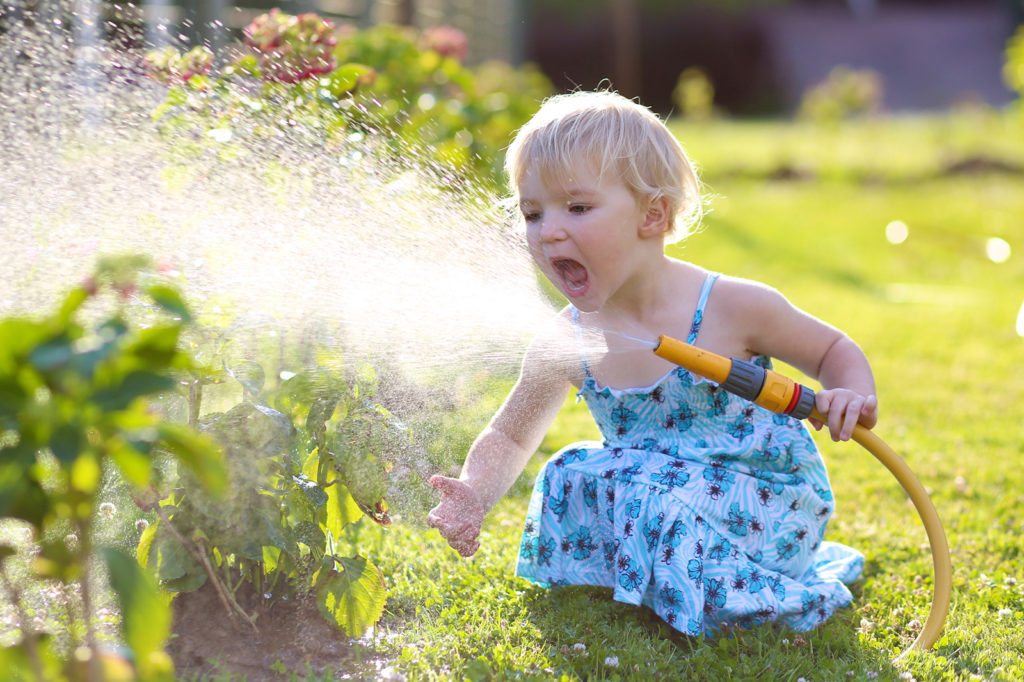Here in the Pacific Northwest, we’re blessed to have abundant rainfall, even throughout the summer at times. However, we still need to water our yards. Summer days might begin with a sprinkle but the long days and lingering light can ultimately result in a dried out yard and parched plants. Learning how to “water smart” is the key to a healthy garden in areas like Tacoma, Bremerton, Port Orchard, Gig Harbor and Bainbridge Island, each possessing their own unique microclimate.
Watering smart doesn’t mean only utilizing plants that need little to no water. While hardscaping can prove an attractive option, you might prefer plants in your yard. If this is the case, you, the smart Northwest gardener, needs to make use of good watering principles and practices. Here are a few tips:
- The biggest water hog in the Northwest and beyond, is usually the lawn. By replacing a segment of your lawn with a hardscape, pavers, or ground cover, you’ve already taken a big step toward water savings. If a lawn is a must in your yard, try planting Perennial Ryegrass or Fescue. Both of these grasses require much less water than Bentgrass or Bluegrass.
- Mow your lawn to the proper height. Setting the mower to a 3” – 4” cut will keep the soil cooler. Additionally, a longer lawn in the Pacific Northwest creates a cushy platform on which to walk or recline on picnic days.
- After mowing, leave the grass clippings in place. Clippings break down quickly and replace nutrients in the soil. Mow often so you don’t shock the grass by removing too much of the grass blade at once. Additionally, if you only mow once in a while, the clumps of clippings can smother your lawn.
- Our summer climate generally remains in the 70s or 80s. At these temps, your lawn will need about an inch of water per week. Try staggering your watering to a half inch two to three times a week. Or, try waiting until the lawn becomes dull green in color or begins to wilt.
- An Eco-lawn can provide a pleasing solution to a grass lawn. Eco-lawns consist of a mixture of grasses, clovers, and flowering plants, such as, English Daisies, Roman Chamomile, Sweet Allysum and Yarrow. They look pretty and use far less water than a grass lawn. Seed mixtures can be found at most nurseries as well as online. Make sure and choose a seed mix for our region, such as the Northern Ecology Mix for the Puget Sound area, which includes colonial bent grass; strawberry and Dutch white clover (Trifolium species); the flowering perennials English daisy (Bellis perennis), Roman chamomile (Anthemis nobilis) and yarrow (Achillea millefolium); and an annual, baby blue eyes (Nemophila menziesii).
- Clover also works as an easy-care alternative to grass lawns. Clover is a nitrogen fixer and provides nutrients for the other plants, which means less fertilizer application.
- Try interspersing a hardscape into your yard. Again, by reducing the amount of lawn in your garden, you effectively reduce the amount of water you need. We’ve got some great ideas for hardscapes. Take a look at this article to get your creative juices flowing.
- Feed your lawn and garden at regular intervals. A healthy lawn stands a better chance at crowding out weeds. It also helps the lawn deal with the stresses of heat and drought.
- Lastly, if you can stand it, let your lawn go in the summer. Mother Nature generally provides enough rain to produce a healthy lawn. In the summer, you can let your lawn go dormant. Grasses are amazingly resilient and can last up to two months if left alone. When the rains return, your lawn will bounce back and return to its green lushness.
By employing any or all of these techniques, you’ll no doubt find your water bill dropping significantly.
If you need help with any aspects of your yard, give us a call at (360) 265-5231. We can design a water reducing hardscape or paver patio, plant a new lawn or install a sprinkler system.
